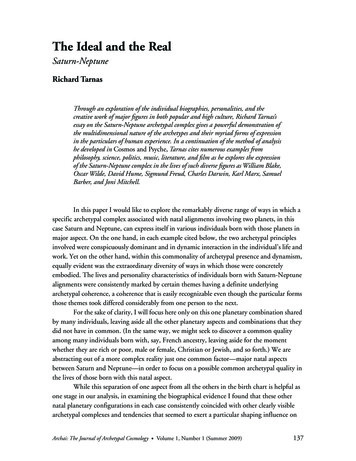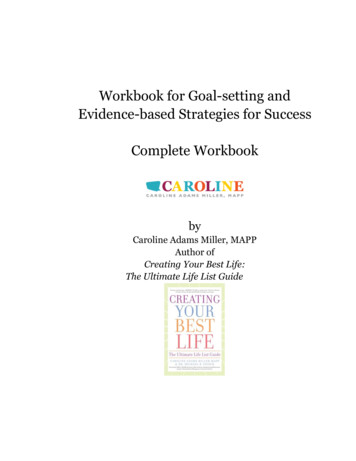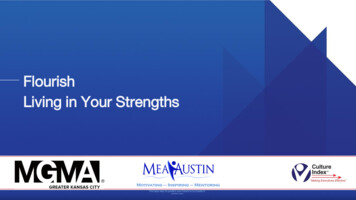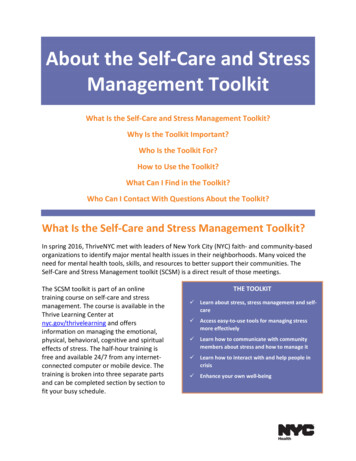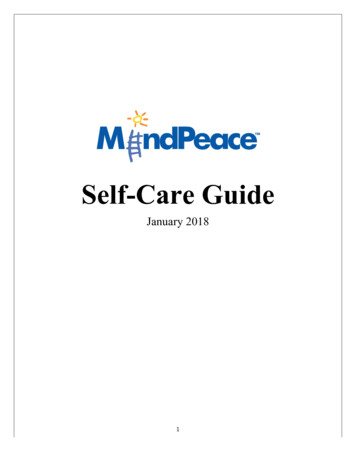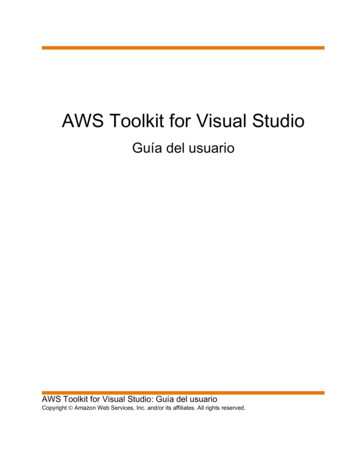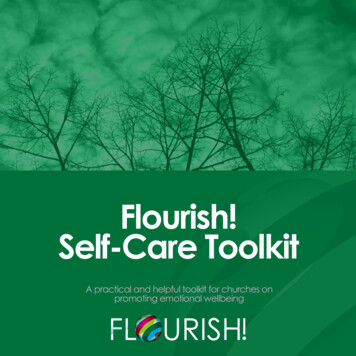
Transcription
Flourish!Self-Care ToolkitA practical and helpful toolkit for churches onpromoting emotional wellbeing
IntroductionWhat carepracticep8WellBeingAuditp16What areother clergydoingfor theirself-carepractice?p18How dowe knowthat weneedself-carepractice?p6IntroductionA journey from ‘workaholism’ to self-care consciousness.10minuteideasScripturalreflectionon selfcareThis resource is created in recognition of the need for self-care practice to protect the health andwellbeing of Clergy as they take on their important and valued work with individuals, families andcommunities who are living with ever increasing levels of emotional distress.p10p22In his book Riding The Dragon Robert Wicks draws the followinganalogy between ministers and camels: “Camels are fascinatinganimals. They can walk through the desert carrying their cargofor days without water. They are able to carry very heavyburdens. Yet, even these wonderfully sturdy animals will dryup, fall down, and die if they are unable to find water andrest at some point . . . Like sturdy animals, ministers are ableto journey with others in the most difficult circumstances,helping them to shoulder their burdens throughpsychological and spiritual deserts, but for them to surviveand thrive they must find oases of peace and joy or theywill dry up themselves . . . And so they need to be awareof their own oases and renewal zones. Renewal zones areessential if we are to remain compassionate and grateful. “p3
Often we go too long without checking in with our renewalzones and we become stressed. There is good stress. Thepathway to flourishing - It’s when we’re doing what wefeel called to do and when we’re positive and eagerabout the challenges we face.There is bad stress, the pathway to burnout: “a state ofphysical, emotional and mental exhaustion markedby physical depletion and chronic fatigue, feelings ofhelplessness and hopelessness, and by developmentof negative self-concept and negative attitudes towardswork, life and other people.”, as defined by ChristineMaslach in her article “Burned-Out”.It’s when we’re doingwhat we feel called todo and when we’repositive and eagerabout the challengeswe s)The latter is not a destination any of us want to reach andit can be avoided by taking responsibility for our self-care .It is our hope that this resource will encourage you to reflect on your own renewal zones and needs forincorporating self-care practice into the heart of delivering your important vocational work.We hope that you enjoy browsing through the content, that you enjoy the beautiful visual imagery contributedby local photographers.Most of all we hope that you will feel encouraged to take action on yourown self-care practice.p4What is self-care ?Simply put, self-carepractice is learningabout and integratingwhat nourishes andrenews us personallyand professionally.p5
How do we know that we need self-care?Signs: Our bodies have powerful inbuilt feedback systems which are available to us and enable usto sense when we are experiencing distress.Our Emotional Feedback System is activelycommunicating and helping us to noticewhen we are and are not congruent andaligned physically, mentally and spiritually.Accepting our emotions unconditionally is astarting point, being curious about what it isthey are telling us about what is working andnot working for us right now.Resistance is another powerful physicalfeedback system within our bodies.Notice any resistance that you might haveto an emotion, an activity, a situation. Ifyou sense that you are forcing yourself,pushing through a situation or experiencingresistance, it is your body’s way of helpingyou recognise more consciously that youare out of alignment. Something now needsto shift or change for health to be restored.What will enable you to feel more personallyaligned.Emotional Signs UpsetConfusedAnxiousLow MoodIrritation gmoodsResistance SignsGenerally heard in the inner voice: I don’t want to do this Why are they makingme do this?I don’t want to go but Ihave to go Why is this happeningto me? If I just do this it will allbe betterI can’t stop nowPhysical SignsPhysical Feedback:When your body is not receiving whatis necessary for its health, welfare,maintenance and protection it has apowerful feedback system which alertsyou. This can be manifested in a range ofphysical symptoms ranging from minorailments through to debilitating illness.p6 Reoccurring cold, flu Exhaustion and fatigue Over/under sleeping Higher heart rate Reduced Libido Change in breathing Aches and pains Breathing from thechest Immune systemcompromised. Poor concentration Over/under eatingPressures Compassion RestThe Minister’s dilemmaPressures placed upon those engaged in ministry are not new. Already in thegospels we find evidence that stress and strain were part of the life of Jesus’ coworkers. In Mark’s gospel there is a passage in which we see Jesus manifestingconcern for His disciples’ well-being. Jesus said to them: You must come awayto some lonely place, all by yourselves and rest for a while; for there were somany coming and going that the apostles had no time even to eat. (Mark 6:31).In the verses that follow we read: The disciples went off in a boat to a lonelyplace where they could be by themselves, the people saw this and many couldguess where they were going; and from every town they all hurried to the placeon foot and reached it before them. Jesus was moved with compassion when hesaw the crowd, He took pity on them and began to minister to them in their need(Mark 6:32). Clearly, Jesus discerned on that day that the people’s clamour for help simplycould not be ignored; He esteemed that their needs merited immediate attention.Scripturalsupport forself-care:If, on occasion, Jesus felt obliged to delay His plans for rest and recuperation before the pressing demands made of Him,He was never entirely deterred from creating the time and finding the space to recoup His expended energies. Jesusknew that He needed time to commune with His Father in prayer if He was to be able to respond to the many demandsmade upon Him. We are told how Jesus would often go off to a place apart in the early morning. Christ would get awaybefore those around Him were able to hinder Him from doing so.The gospels also show us how Jesus invited His disciples to come aside with Him to lonely places. The Transfigurationwas one such moment. What happened on the Mount of Transfiguration had for purpose to enlighten and preparethose Jesus associated with Him in His ministry for what lay ahead of them, to help them make sense out of it. AlbertCamus’ insight comes to mind here: In order to understand the world, one has to turn away from it on occasion. Christianministers do well to apply this principle to their ministry. Times of quiet retreat can help them better discern and respondto people’s needs.If Christian ministers today are called to be compassionate as Jesus was during His earthly ministry, this will sometimeslead them to discern that well-laid plans for respite and rest just have to be delayed on occasion; but, if they are true toJesus’ example, they will be careful not to completely ignore their need for regular recuperation. It is indispensable forthose who care for others not only to find, but to actively create, time and the restful space wherein they can revive theirdrooping spirits (Psalm 23).Ministers’ own well-being is enhanced by them taking desert periods, finding quiet, uncluttered places in which toexperience restoration. They need to relax and recreate. In recreation they can find themselves quite literally re-created.p7
Considerations whenintroducing self-carepracticeWisdom:Prayer. Give me the wisdom to take good care of myself so that Imay be equipped to care for others from a healthy place.Clarity:Be clear with your reasons for self-care practice.Balance:Self-care practice requires us to attend to many facets of our healthand wellbeing. Self-care practice means seeking to balance thesemany facets and weave them into the fabric of our lives. The 6 keyelements of self-care can be described as physical health, emotionalhealth, psychological health, spiritual health, personal health andcareer/work health.Mind Shift:Schedule work and commitments around your self-care practicerather than planning self-care practice around your work andcommitments.p8p9
10 Minute Ideas:Caregiver self-care and well-being is often overlooked in this fast-paced worldwith the multitude of requirements and demands put on clergy, whether it beincreased paperwork, productivity, or stretching ourselves thin in order to help moreparishioners. So how do we self-care? How do we unwind from the intensity of ourwork and issues we face?The answers to those questions will be unique to each of us, yet have common threads as well. Someof us will find our renewal zones in gardening, crafting, socialising with friends, going to the cinema,dancing, exercising, reading and even in ironing! The list is endless and your list of self-care activitieswill be unique to your personality, interests, and likes.There are however commonalities in our self-care activities these can be described as the need for personaloutlets away from the job, the need to find activities that bring us pleasure and replenish us, the need forsupervision and mentoring, and the need to connect with our kindred spirits, caregivers like us who canidentify with the stressors that accompany our line of work.Being time poor doesn’t mean self-care practice cannot happen, these activities will help support an aspectof self-care on those super busy days where 10 minutes is all you have. Keep in mind though that self-carepractice requires a wider more holistic and balanced commitment and approach.TakeNotice Take ten minutes in the morning to sit withyourself and to notice how you are feeling,physically, emotionally, spiritually. Take ten minutes before bed and complete apersonal reflection journal Change your state by moving - vary whereyou sit Get out of the car and walk Plan to arrive 10 minutes early to house calls,hospital visits and meetings and take thistime to listen to an uplifting or mind clearingpod cast or walk around the vicinityStretch Rotate slowly 8 times in both directions yourankles, knees, hips, shoulders and wrists.Your 10minwork out! Neck: Gently move your neck from centre inthe direction of your right shoulder, hold for5 seconds and bring back to the centre andhold for 5 seconds. Then repeat to the left.Repeat this 4 times to loosen your neck. Power Stretch: Feet apart, arms above yourhead - stretch and hold for 2 minutes. Shake it all out and you’re ready to go! Breathe. in for a count of 2 out for a count of 2, in for a count of 3 out for a count of 3, in for a count of 4 out for a count of 4, repeatup to 10 timesMoveBreathep10p11
Dream BeFind your favourite Guided Meditations.There are a host available online which youcan download to your phone or tablet somewhere that you can access them easily.Choose a few with different objectives e.g.one that is relaxing, one that is motivating,one that is reassuring, one that allows you toescape etc. Also think about their durations- it is useful to have a 2min, 5min and 7minversion at hand. Now it’s as simple as sittingback, closing your eyes and listening.OffCreate1. Find a chair in a quiet place where you willbe undisturbed and feel comfortable.2. Wherever you are you become mindful ofyour breath and the sensations in your body.3. You begin to become aware of where yourbody makes contact with the chair and howthat feels.Read inspirational poetry or literatureComplete a mindfulness Body Scan(on opposite page)SwitchThe Body Scan Switch off your phone, Mute your emails, Switch off your television Sing Sketch Colour in a Mandelap124. Focusing on each out breath you allowyourself to let go as you sink a little deeperinto the chair.10 Minute Ideafoot in turn, bringing a gentle curiosity toinvestigate the quality of the sensations youfind, perhaps noticing the sense of contactbetween the toes, a sense of tingling,warmth, or no particular sensation. Feel theleft foot in your sock or shoes and noticethe sensation, the pressure, the feeling.Become aware of your heel, and the instepand notice how they are making contact. Asyou do this you slowly bring your attentionto your right foot and repeat the exercise,focusing at first on each of your toes andthen right though your right foot.8. All the time breathing in and out - no rightno wrong breathing, just perfect breathcreating life, in and out.5. Set an intention for this practice “I aim tobring awareness to the sensations in mybody as I tune into how I am right now”.9. When you are ready for an in-breath, feel or6. Now bring your awareness to the physicalimagine the breath entering the lungs, andsensations in the lower abdomen, becomingthen passing down into the abdomen, intoaware of the changing patterns of sensationsthe left leg and into the left foot, and out toin the abdominal wall as you breathe in, andthe toes of the left foot.as you breathe out. Take a few minutes tofeel the sensations as you breathe in and as10. Then, on the out-breath, feel or imagineyou breathe out.the breath coming all the way back up, outof the foot, into the leg, up through the7. Having connected with the sensations inabdomen, chest, and out through the nose.the abdomen, bring the focus or “spotlight”As best you can, continue this for a fewof your awareness down the left leg, intobreaths, breathing down into the toes, andthe left foot, and out to the toes of the leftback out from the toes.foot. Focus on each of the toes of the leftp13
11. It may be difficult to get the hang of thisjust practice this “breathing into” as bestyou can, approaching it playfully.12. Repeat this for the right toes and foot.On the in-breath feeling or imaginingthe breath entering the lungs, and thenpassing down into the abdomen, intothe right leg and into the right foot, andout to the toes of the right foot.13. Allow the awareness to begin to expandup through the body, from the feet andinto the ankle through its bones andjoints, moving your focus up towardsthe lower left leg—the calf, shin, knee,thigh, pelvic area, back, abdomen, chest,fingers, hands, arms, shoulders, neck,head, and face.14. In each area, as best you can, bring thesame detailed level of awareness andgentle curiosity to the bodily sensationspresent. As you leave each major area,“breathe in” to it on the in-breath, and letgo of that region on the out-breath.15. When you become aware of tension,or sensations in a particular part of thebody, you can “breathe in” to them—using the in-breath gently to bringawareness right into the sensations,and, as best you can, have a sense oftheir letting go, or releasing, on the outbreath.16. The mind will inevitably wander awayfrom the breath and the body fromtime to time. That is entirely normal. Itis what minds do. When you notice it,gently acknowledge it, noticing wherethe mind has gone off to, and thengently return your attention to the partof the body you intended to focus on.Acknowledge disruptive sounds in thebackground and return your attentionback to the breath and into the bodywhere you intend to focus.17. After you have “scanned” the wholebody in this way, spend a few minutesbeing aware of a sense of the body as awhole, and of the breath flowing freelyin and out of the body.SELF-CARE IS A PRIORITY AND NECESSITY - NOTA LUXURY - IN THE WORK THAT WE DOp14p15
Self-care Wellbeing AuditThis assessment tool provides an overview of effective strategies to maintain self-care . After completing the fullassessment, choose one item from each area that you will actively work to improve.Using the scale below, rate the following areas in terms of frequency:5 Frequently4 Occasionally3 Rarely2 Never1 It never occurred to mePhysical self-carePsychological self-careEat regularly (e.g. breakfast, lunchand dinner)Eat healthyExerciseGet regular medical care for preventionGet medical care when neededTake time off when neededGet massagesDance, swim, walk, run, play sports,sing, or do some other physical activitythat is funGet enough sleepWear clothes you likeTake vacationsTake day trips or mini-vacationsMake time away from telephonesOther:Make time for self-reflectionHave your own personal psychotherapyWrite in a journalRead literature that is unrelated to workDo something at which you are notthe expert or in chargeDecrease stress in your lifeLet others know different aspects of youNotice your inner experience—listen to your thoughts, judgments,beliefs, attitudes, and feelingsEngage your intelligence in a new area,e.g. go to an art museum, history exhibit,sports event, auction, theatre performancePractice receiving from othersBe curiousSay “no” to extra responsibilities sometimesOther:Emotional self-careSpend time with others whose companyyou enjoyStay in contact with important peopleGive yourself affirmations, praise yourselfLove yourselfRe-do favorite books / favorite moviesIdentify comforting activities, objects,relationships, places and seek them outAllow yourself to cryFind things that make you laughExpress your outrage in social action,letters and donations, marches, protestsOther:Spiritual self-careMake time for reflectionSpend time with natureFind a spiritual connection or communityBe open to inspirationCherish your optimism and hopeBe aware of nonmaterial aspects of lifeTry at times not to be in charge or the expertBe open to not knowingIdentify what is meaningful to you andnotice its place in your lifeMeditatePraySingHave experiences of aweContribute to causes in which you believeRead inspirational literature (talks, music, etc.)Other:Workplace or Professional self-careTake a break during the workday (e.g. lunch)Take time to chat with co-workersMake quiet time to complete tasksIdentify projects or tasks that are excitingand rewardingSet limits with your clients and colleaguesBalance your caseload so that no one day orpart of a day is “too much”Arrange your work space so it is relaxingand comfortingGet regular supervision or consultationNegotiate for your needs (benefits, pay raise)Have a peer support groupDevelop a non-trauma area ofprofessional interestOther:BalanceStrive for balance within your work-lifeand workdayStrive for balance among work, family,relationships, play and restWhat stands out that youwant to improve on most?Source: Transforming the Pain: A Workbook on Vicarious Traumatization. Saakvitne, Pearlman & Staff of TSI/CAAP (Norton, 1996)p16p17
What are other clergy doing for theirself-care practice?PsychologicalAtworkcaysiPhVisit the doctoralSpiritualonotiEmPhysical self-careDentist appointmentslEating healthyPersonalRegular ExerciseQuality SleepPsychological self-care ideasPlanned HolidaysEmotional self-careAffirmationsSelf loveSelf CompassionPermission to crySocial Justice WorkLaughterWatch a funny movieFind a hobbyReward yourselfSelf reflectionRegular time outTherapyMassage & AlternativetherapiesJournalAffection and touchPet timePractice ForgivenessSpiritual self-care ideasTime in NatureSpiritual communityMeditateSingBathsSelf AwarenessPlayFostering RelationshipsSelf HelpDanceSwitch off days(the phone)Ask for helpSwim in the oceanReceive helpWatch sunrises andsunsetsSupport GroupsAcknowledge your positivequalitiesSpiritual mentorsFoster self-forgivenessSensory workeg Relax in the sun,Aromatherapy / Draw / Paint /Music/ Dance / Gardenp18p19
At work self-care ideasTime for lunch and breaksSet boundariesKnow your limitsSay no to overtimeLeave work at work - timeoff from work is clearSupervision regularlySupport from colleaguesTake mental health daysPersonal self-care ideasLearn new thingsPersonal DevelopmentHolidaysSetting GoalsSetting IntentionsPsychologicalitualootiEmMake vision boardsFoster friendshipslnaSpirSELF-CARE ISNOT SELFISH. YOUCANNOT SERVE FROMAN EMPTY VESSELGo on dateslcaysiPhAtworkCoffee with friendsRelaxWrite a poem or bookPersonalYou can download these quotes as amotivational powerpoint here:www.wewillflourish.comSpend time with familyCookLearn something newp20p21
Learning to live by the unforcedrhythm of grace Freely and LightlyThere is a well-known passage in Matthew’s gospel wherein we hear Christinviting His disciples to come to Him for rest, so that they may learn from Hisway of being. Eugene Peterson’s paraphrase of this gospel passage capturesthe essence of what Jesus has to say to those who may be feeling weary inministry today. Peterson’s The Message renders Christ’s words recorded inMatthew 11:28-30 in contemporary idiom: Are you tired? Worn out? Burnedout? Come to me. Get away with me and you’ll recover your life. I’ll show youhow to take a real rest. Walk with me and work with me – watch how I do it. Atthis point Peterson introduces a beautiful phrase which is worth pondering. Heplaces on Christ’s lips this instruction: Learn from me the unforced rhythms of grace.I won’t lay anything heavy or ill-fitting on you. Keep company with me and you’ll learnto live freely and lightly.Scripturalsupport forself-care:I allow divine light and love into my heart daily. I livein the present moment, forgiving and releasing allpast hurts. I am now open to receive all of God’sabundant blessings and miracles. Everyday prosperityconsistently flows through all areas of my life. I am sovery grateful. Thank you God!Christian ministers do not always live freely and lightly. They often live with a strong sense of duty and carry a heavyweight of responsibility. How many ministers truly respect the unforced rhythms of grace in their lives? To fail to heed thewarning not to strain oneself unduly can lead many well-intentioned ministers to follow a dangerous course of actionand, ultimately, to act irresponsibly – in their own regard and in other people’s regard as a consequence. It costs a persondearly to lose their proper rhythm. A life out of sync becomes unhealthy and is at risk of break-down. Compassion fatiguesets in when a minister’s heart is permanently under strain. A story from the early Christian monastic tradition captures thiswell. In the Sayings of the Desert Fathers we read a story which speaks of the need to relax before one reaches breakingpoint. It encourages God’s servants who are under strain to enjoy life a little more, so as to better serve the needs ofthose they are called to care for. A hunter in the desert saw Abba Anthony enjoying himself with the brethren and he wasshocked. Wanting to show him that it was necessary sometimes to meet the needs of the brethren, the old man said tohim, ‘Put an arrow in your bow and shoot it.’ So he did. The old man then said, ‘Shoot yet again,’ and the hunter replied ‘If Ibend my bow so much I will break it.’ Then the old man said to him, ‘It is the same with the work of God. If we stretch thebrethren beyond measure they will soon break. Sometimes it is necessary to come down to meet their needs.’ When heheard these words the hunter was pierced by compunction and, greatly edified by the old man, he went away. As for thebrethren, they went home strengthened. It is surely encouraging to see how the austere desert saint, Anthony the Great,insisted upon the importance of relaxation in order to serve God and others without being stressed and strained to thepoint of breakdown.The first step in many pastor’s efforts to arrive at a healthier life-style will be to recover the unforced rhythm of grace intheir lives. For some who have always pushed themselves in their care for others, the challenge may be to discover thisunforced rhythm of grace for the very first time.p22p23
Safe-care Self-protection Trust in GodThe exercise of self-care actually begins by putting in place self-protection.As we have seen, the gospels show us how Jesus was anxious to protect Hisdisciples from the constant pressures they were under. Admittedly, certainpressures are completely beyond a pastor’s control, but it happens that manypressures, and the strain that accompanies them, can be due, at least in part, to afailure on behalf of Christian ministers to respect their personal limitations and putproper boundaries in place in their lives.Scripturalsupport forself-care:When nothing is set in place to safeguard a minister’s own well-being, he or she willbecome completely worn out. Christian pastors can and do fall prey to onslaughts of anxiety.The apostle Paul clearly found himself under great pressure much of the time. In his writings he shares with his readersstrategies which can help ministers today to guard themselves against the troubles they encounter in their lives. Theapostle was clearly aware that pressures of all sorts can so easily distort the Christian minister’s thought patterns. Inhis Letters to the Colossians and to the Philippians, Paul gave sound advice which Christian ministers of our own daywould do well to be pay heed to. In Colossians 3:2 he writes: Clearly there is little point in spending time worrying aboutthings, for this will only serve to further weaken the troubled mind. In Philippians 4:4-7 he comes back upon the futility ofworrying unnecessarily and encourages his readers to express their concerns honestly in their prayer. His advice is clear:Every need and worry should be handed over to God, coupled with a prayer of thanksgiving. The Apostle insists upon theimportance of believers recognising the good things happening within and around them.While encouragement is given to help others carry their burdens, a warning has to be given against the tendency forministers to allow themselves to become unduly laden by other people’s burdens to the extent that they are renderedineffective and are devoid of the energy they need to be of help to those to whom they are called to minister.p24If we are braveenough oftenenough, wewill fall; this isthe physics ofvulnerability.Brené BrownJoshua 1:9Be strong andcourageous. Donot fear, do not bedismayed, for the Lordyour God is with youwherever you go.Deuteronomy31:6 Be strongand courageous.Do not fear or be indread. The Lord yourGod goes with you.He will not forsakeyou.Philippians 4:6-7Do not be anxious aboutanything, but in everything byprayer and suppliccation withthanksgiving let your requestsbe made known to God. And thepeace of God, which surpassesall understanding, will guardyour hearts and your mindsin Christ Jesus.Isaiah 41:10Fear not, forI am withyou, be notdismayed1 Peter 5:7 Castall your anxietieson the Lord,because He caresfor you.p25Psalm 53: 3When I amafraid, I putmy trust inYou.Matthew 6: 23-34Therefore I tell you,do not be anxious aboutyour life. ( ) Which ofyou being anxious canadd a single hour to hisspan of life?
The Psalms: Honesty in Prayer Expressing EmotionsThe truthis, rarely cana response makesomething better — whatmakes something betteris connection. And thatconnection often requiresmutual vulnerability.Oursis a culture soconsumed with therelentless pursuit ofhappiness, its secrets andBrené Brownits science, that it layers overthe already uncomfortablestate of unhappiness a stigmaof humiliation and shame. Butunhappiness can have its ownOur way ofdignity and can tell us as much,thinking, our intellect,if not more, about who weour affect, our personalityare than happiness.— these aren’t things weexpect will ever change. Wetake them for granted. We fearhaving an accident that will makeus paralyzed, change our ability tomove around, or cause us to loseour hearing or sight. But we don’tthink about having an accidentthat will cause us to loseourselves.Brené BrownAlbert CamusThe quality of presence, an abilityto project poised confidence,passion, and enthusiasm inhigh-pressure situations, whichcan’t be easily faked but can bedeliberately cultivated.Amy Cuddyp26Jesus’ prayer was largely fashioned by that of the Book of Psalms. He was soevidently familiar with this Book of the Praises of Israel. The psalmist speaksfrequently of trusting in the Lord and again of waiting patiently on the Lord,holding one’s heart and mind in silence and in peace. To this attitude proposedby the Psalmist, the prophet Isaiah responds, making a promise of renewedstrength to those who trust in God. Isaiah states: They that wait for the Lord shallrenew their strength. They shall mount up with wings like eagles; they shall runand not be weary; they shall walk and not faint. (Is. 40:31).Scripturalsupport forself-care:While it is undoubtedly important for Christian ministers to halt and take quiet time tolisten to the Lord, it is also vital for them to honestly express their own emotions in prayer.In light of this, it seems appropriate at this point to offer a brief reflection on how the prayer of the Psalms can bebeneficial to Christian ministers wanting to practice proper self-care.The first thing the Psalms do is to liberate those who pray them to be completely honest in their prayer. The Psalmistencourages his readers to dare to pray through their life experience in frankness and without pretence or censure of anykind. The psalms encourage those who use them to pray in simplicity of heart.It is impossible to express adequately the richness, the breadth and the depth of the wide and varied collection of prayerscontained in the Psalter. The Psalms look to God in moments of personal despair and community disaster, at times ofcommunal suffering and national rejoicing. Again and again, God’s People is shown to have found release by expressingtheir heartfelt laments and in giving voice to their praise and thanksgiving in prayer. This collection of poetic prayerformulae is brimming with a wide range of honest emotions. It gives expression to anguish and adoration, suffering andcompassion, hopes and fears, joys and sorrows. In some psalms the psalmist is heard to openly questi
Well Being Audit How do we know that we need self-care practice? 10 minute ideas A journey from ‘workaholism’ to self-care consciousness. This resource is created in recognition of the need for self-care practice to protect the health and wellbeing of Clergy as they take on their



